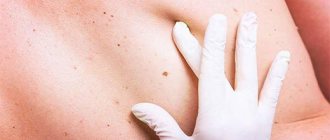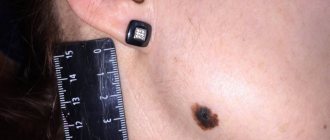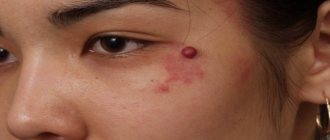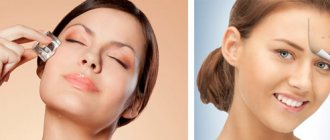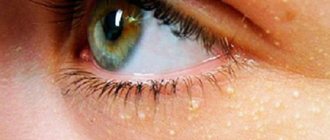Why are moles removed and is it possible to do it?
Everyone has moles, only some moles do not bother them, while others cause real trouble. In general, birthmarks can cause discomfort to the owner, this is true. Troubles may be associated with:
- discomfort in everyday life when a mole is rubbed, frequent tearing off of moles, etc.,
- the aesthetic side of a mole, especially when it occupies the face, neck, décolleté (as a rule, hanging, convex moles and pigmented spots are not liked),
- negative growth of a mole.
Moles are benign tumors on your body, therefore, on the one hand, you should not be afraid of them, but on the other hand, they may well develop into malignant formations.
For this reason, moles should be checked regularly, especially if they are large, heterogeneous, or when they begin to grow sharply or change in shape and color.
Any changes in moles are a reason to consult a specialist for examination. The same applies to cases when you accidentally rip off a mole, which is accompanied by heavy blood loss from the injured area of skin.
It would be right to always monitor your health and especially your moles, so as not to start the development of a congenital tumor and stop it if necessary.
Of course, there is no point in removing all moles in a row, because they can give you confidence and charm. But moles that cause discomfort and problems are not only possible, but also necessary.
The only thing that should not be forgotten is that moles can only be removed by a specialist; you should not even try to solve your problem yourself or with the help of unqualified people.
So, if you feel at risk from a suspicious mole on your body, consult a doctor for advice on how to get rid of moles forever and whether it is worth doing this in your case, or immediately after removing the mole.
It is also worth removing harmful moles that develop into malignant tumors. But the word “needs to be removed” does not apply to unaesthetic moles - it’s just a matter of your will: remove the mole or leave it as your own special feature.
Indications for removal of hanging moles
Most birthmarks are harmless and no removal procedure is required. It is obligatory to remove the tumor, the cells of which are at the stage of degeneration into melanoma (malignant tumor).
Conditional indications for disposal:
- change in color, diameter, shape, size of the nevus;
- the mole is in an inconvenient place, where it is constantly exposed to friction against clothing and sweat;
- unpleasant symptoms: itching, burning, pain, swelling at the site of the tumor;
- inflammatory process;
- formation of nodules;
- thickening of the mole, change in structure.
Preparations for removing nevi
Traditional healers practice another ancient recipe for getting rid of unwanted moles. You need to take exactly seven boiled chicken yolks, add five tablespoons of dry pumpkin seeds and flour to them.
The resulting mixture is poured with 500 g of vegetable oil, mixed thoroughly and left in a water bath for half an hour.
There are several drugs, the use of which will help remove a mole on the face and other parts of the body at home:
- "Malavit." It contains more than 30 herbs that are collected in Altai, and it also contains acids and minerals. The process of use is simple: you need to apply the ointment to a cotton swab and apply it to the nevus. All this is fixed with adhesive tape. The procedure must be carried out every 2 days.
"Stefalin" has a profound effect on the mole
In addition to folk remedies for reducing tumors, you can try to purchase special medications in pharmacies. The following give good results:
- Stefalin;
- Super clean;
- Feresol;
- Verrucacid;
- Panavir;
- Oxolinic ointment.
Pharmacy products will be an excellent solution if you need to remove a mole from your face. They are not as aggressive as traditional methods. They must be used according to the instructions, and it is better to consult a doctor before doing so.
Precautionary measures
When removing a mole at home, you need to be sure that the neoplasm is not malignant. It cannot be removed at home.
Contraindications for removal
- exacerbation of chronic diseases;
- infectious diseases;
- dermatoses;
- the presence of open wounds, abrasions, and other pigment spots near the tumor;
- the mole is at the stage of transformation into melanoma.
Timely consultation with a doctor and correct diagnosis will help prevent the neoplasm from becoming malignant. If there is no effect as a result of using traditional methods, the doctor will suggest hardware procedures: radio wave method, cryodestruction, laser exposure, removal with high-frequency electric current.
When a person discovers an elongated formation that protrudes above the skin level, he wonders why hanging moles appear, whether they are dangerous to health, and what to do with them.
Removal methods at home
There are many ways to help remove moles from the surface of the body. You can try this with garlic.
You need to crush the clove, apply the mixture to a tampon and apply it to the tumor, securing everything with a band-aid. After 5 hours, you can remove it and wash off the remaining garlic with warm water.
You will need to do from 5 to 10 procedures. Soon the mole will become smaller and disappear completely.
For those who have sensitive skin, it is recommended to reduce tumors with iodine. The product is applied to the mole using a cotton swab three times a day.
The procedure should be repeated until the problem completely disappears. This usually takes at least 2 weeks.
Iodine can be used to remove nevi from the face, but it is worth remembering that it leaves yellow spots that are difficult to wash off.
Celandine is a plant that will help remove tumors in a short time. You should squeeze the juice from fresh leaves and apply it with a cotton swab to the problem area.
Cryodestruction
Cryodestruction is a method of removing moles using liquid nitrogen. In this case, the tissues of the formation are frozen and die over time.
The main advantage of this method is its low cost, and the disadvantages include:
- lack of guarantees of complete removal of the nevus, due to the inability to control the depth of tissue freezing;
- the possibility of getting a thermal burn, the healing of which is accompanied by tissue scarring;
- long recovery period.
Consequences of removing moles on the body
After direct removal of the mole, a recovery period follows, which is characterized by the formation of wounds or scars. Such consequences require special care.
Wound care after mole removal
The recovery period includes a number of restrictions. After removing moles, you should exclude the following:
- Taking medications without the consent of a doctor;
- Applying decorative cosmetics and using other cosmetics for the treated area;
- Wetting and steaming for 5 days;
- Any mechanical impact;
- Drinking alcohol within 7 days;
- Sunbathing, going to the solarium.
On the first day after removal, lotions with manganese are applied to the treated surface; some experts even recommend using brilliant green. Drugs with wound healing and antibacterial properties are also used. It is forbidden to remove the crust yourself to avoid infection and scar formation.
Scar care after mole removal
After complete healing of the wound, scars may form. They should be treated with sunscreen with the highest protection rating or covered with clothing or a bandage to avoid re-excessive production of melanin in this area. The scar can also be treated with cocoa butter, which can reduce its size. https://www.youtube.com/watch?v=9-dC1YbA5mA
Post Views: 1,204
Features of removal depending on location
Depending on the location, the reasons for the formation of nevi can be assumed.
| Localization area | Factors in the formation of neoplasms |
| Armpits |
|
| Genitals, groin |
|
| Neck area, décolleté |
|
| Hands |
|
| Legs |
|
| Abdomen area |
|
The location of hanging moles, which is the most dangerous
The main percentage of all hanging moles are benign formations and do not pose a danger to humans. In case of degeneration into a malignant formation, its removal is required. Those people who have hanging moles on their chests and faces often have complexes associated with their appearance. They often wonder how to remove a hanging mole at home. It is worth remembering that you cannot tear it off.
Places where hanging nevi cause particular discomfort and are dangerous include:
The neck is one of the areas that is constantly exposed to mechanical stress. This could be from wearing high-necked clothes, wearing jewelry, or scratching. As a result, hanging moles on the neck can be easily damaged. There is an option that with such damage, the nevus may dry out and fall off on its own after a short period of time. Such injury threatens infection in the wound. It will begin to swell, hurt and bleed. This increases the risk of cancer cells multiplying in the nevus. It should be remembered that if a growth located on the neck is accidentally damaged, it is necessary to lubricate the area with an antiseptic or a special one.
An effective treatment solution is 3% hydrogen peroxide. Soak a cotton swab generously in the solution and apply it to the torn mole. Hold it until blood stops coming out of it. Then apply the patch. If the nevus begins to swell and turn red, you should immediately consult a doctor.
On the back
This arrangement of a hanging nevus is dangerous because there is an increased risk of damage to it when scratching the back. The majority of cases indicate that a person is not even aware of its presence in such a part of the body. He can find out about it only through unintentional injury, or from the words of a stranger. Often people encounter nevi on their shoulders. This phenomenon is especially unpleasant for women who wear underwear and bags, due to which formations can be constantly torn off. It is worth thinking about removing such moles.
Armpits
The axillary localization of a hanging mole is dangerous because it can be cut off during shaving of the armpits. This type of damage is undesirable because microbes can enter the wound and activate the inflammation process. The inflammatory process can result in the development of cancer if the hanging mole under the arm was cut off and poorly treated.
In the groin
The presence of a hanging nevus in an intimate place causes great discomfort for both women and men. This arrangement can limit human movement: shaving becomes difficult, and it is uncomfortable to wash this area. Women will have to give up some types of women's underwear and any tight clothing. Such formations in this area can be injured during intimate life.
On the head
Another unfortunate place where hanging nevi can form is the head. It is very easy to damage a mole in this place. This can happen during normal combing or when cutting hair. In such cases, in order to avoid permanent damage, it is recommended to remove them, since injury to the nevus can lead to activation of the inflammatory process. The consequence may be the proliferation of cancer cells.
Diagnostics
In order to resolve the issue related to a hanging tumor, you should contact a dermatologist or oncologist. The doctor will first examine the person’s skin on which the nevi are located. In addition to examination and palpation, a dermatologist can refer you to one of the following diagnostic methods: cytology, microscopy, histology. The doctor’s further actions will consist of either treating the nevus or removing it.
To see a doctor, a person must observe one of the following signs:
- hairs have disappeared from the mole;
- purulent or watery discharge;
- the nevus has changed in size;
- the mole began to itch and hurt;
- bleeding;
- the surface of the formation peels off;
- the upper part of the nevus has acquired a shiny hue;
- formation of a crust on the nevus.
Types of nevi
- Hemangioma;
- Flat views;
- Convex views;
- Large pigment spots;
- Blue moles.
There are many types of nevi, the most common is hemangioma, this is the so-called hanging type of moles, which is why they look like warts. As for flat species, they are almost harmless to humans, since they cannot become inflamed or transform into a malignant tumor. Convex types of nevus are a growth, the base of which is inside the skin; at the convex end there may be hair particles.
Under no circumstances should they be pulled out; hair particles, if they cause aesthetic discomfort, can be trimmed. When large pigment spots appear on the body, this may be due to a genetic predisposition. And finally, blue birthmarks, in particular, this is a hemisphere that protrudes above the skin. In principle, this phenomenon does not pose a threat when exposed to ultraviolet radiation.
Large moles
Large formations on the skin are pigment spots. When they remain unchanged and do not cause inconvenience, this is not a dangerous phenomenon. It is important to constantly monitor their appearance, color, and size. To eliminate worries, you need to consult a dermatologist. During the visit, the specialist will conduct a diagnosis and give a forecast of the risk of developing a malignant neoplasm. Large moles become dangerous if they:
- injured;
- thickened;
- started to itch;
- were unsuccessfully removed independently;
- changed in size, shape;
- are bleeding.
When is it necessary to remove nevi?
Remember the reasons and signs that require immediate consultation with a dermatologist and, possibly, an oncologist:
- you accidentally damaged a birthmark;
- hairs began to grow from within;
- the surface of the mole is cracked;
- fluid or bloody discharge gradually comes out from inside;
- the location of the nevus begins to turn red and itch, there is a burning sensation and pain;
- the boundaries of benign formation have become unclear;
- size, shape, color have changed;
- you have noticed a sharp increase in the number of new birthmarks.
Important! After consultation, the doctor will offer a solution to the problem. There are cases when refusing to remove birthmarks can result in disaster.
Is it possible to remove moles on the body? You need to get rid of nevi in several cases:
- the appearance of the mole has changed dramatically;
- you have injured any type of nevus;
- moles are located in areas where they can be easily torn off or damaged, for example, on the neck;
- large formations disfigure the face, being a noticeable cosmetic defect.
Treatment methods and whether hanging moles need to be removed
If the neoplasms do not cause discomfort to a person, it is recommended not to resort to removal of hanging moles. If the hanging mole is located in a visible place, or where it is constantly damaged, then you can use traditional methods to help remove the formations. But it is still recommended to seek help from a specialist.
Treatment prescribed by a doctor may consist of the following:
- Uses of malavit. The drug contains more than 35 varieties of herbs and minerals that can quickly eliminate unpleasant skin conditions.
- Stefalin. The product consists of plant components. The drug is applied to the hanging formation, and an adhesive plaster is placed on top. The medicine must be applied twice a day to achieve the desired effect in a short time.
- Application of Collomak. The effect of this drug is aimed at softening the top layer of skin. Regular use of the product for 4-5 days can cause it to fall off.
If a person is indicated for removal of a nevus, it can be done using several effective methods: laser, surgical, cryodestruction, using current or radio waves. Such methods are popular and have many positive reviews from patients. The laser method involves cauterizing the mole with a laser beam. There is no bleeding during the process, as the vessels are sealed.
Surgical intervention is performed in cases where the formation reaches a large size or is malignant. The cryodestruction method is one of the most popular. The process uses liquid nitrogen. This procedure should be carried out by a qualified practitioner. The disadvantage of the operation is that the scar may swell and hurt.
During electrocoagulation, a neoplasm is influenced using high-frequency electric current. This procedure is highly effective. The radio wave coagulation method is indicated for those people who have thin and sensitive skin. After completion of the procedure, there will be no scar or scar left at the intervention site. Many methods allow a person to choose exactly how to get rid of hanging moles.
Ways to get rid of moles.
There are several ways to get rid of moles. There are several of them in medicine. Some clinics offer only 1-2 options for getting rid of moles, others offer the whole range of services.
UNACCEPTABLE! Do not under any circumstances try to get rid of moles at home, this is dangerous for your health. It’s better to go to a medical facility and forget about your health problems forever!
So, here are the options for removing a mole:
- Surgical excision of a mole. This method can only be carried out by a specialist. Excision of a mole has long proven its worth; some experts consider the method to be outdated, but it is what is used when removing large moles. The method is old, but proven and reliable;
- Laser mole removal. A modern and popular method of how to get rid of a mole on the body. This option for getting rid of a nevus is the safest, because during the procedure the doctor does not even touch your mole. If necessary, you can arrange for anesthesia from a specialist, although you will only feel a slight tingling sensation and not pain. This also includes vaporization of a mole - when the mole is not removed with a laser, but is evaporated;
- Electrocoagulation against moles. This method is also very popular among modern patients. A mole is removed very quickly in one go using direct and alternating current;
- Cryodestruction. The method is less popular due to the long healing of the wound from a removed mole and the possible need for a repeat procedure. However, there are also advantages: with the help of liquid nitrogen, a mole is removed, but dead tissue is not removed, turning into a crust under which new tissue appears;
- Radiosurgery or thermal scalpel. A very attractive option for mole removal, because... leaves no pain, no marks, no blood during and after the procedure;
- Photodynamic therapy. You simply won’t come across such advertising, because... This therapy is carried out only when the mole begins to develop into a malignant tumor. The procedure consists of two stages: first, a special cream is applied to the dangerous mole, then the mole is exposed to ultraviolet radiation.
It is worth noting that during surgical excision of a mole, cosmetic sutures may be applied, but no specialist will be able to assure that a scar will not remain in the place where the mole was - this is possible. After laser removal of a mole, a small hole remains on the skin, which disappears within up to 2 weeks.


